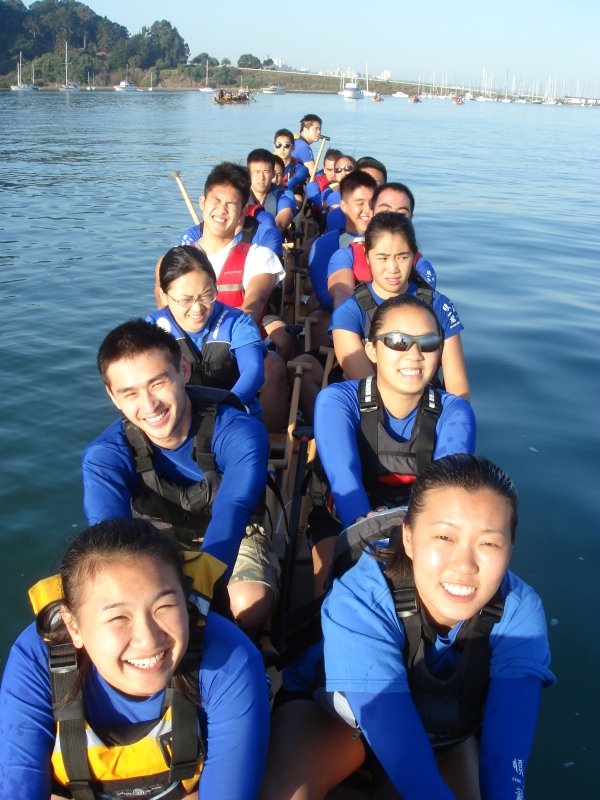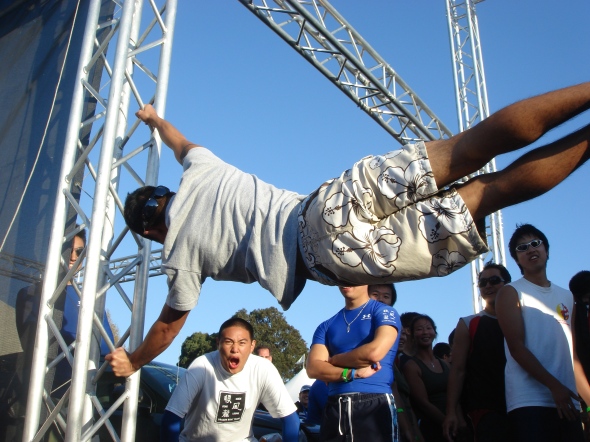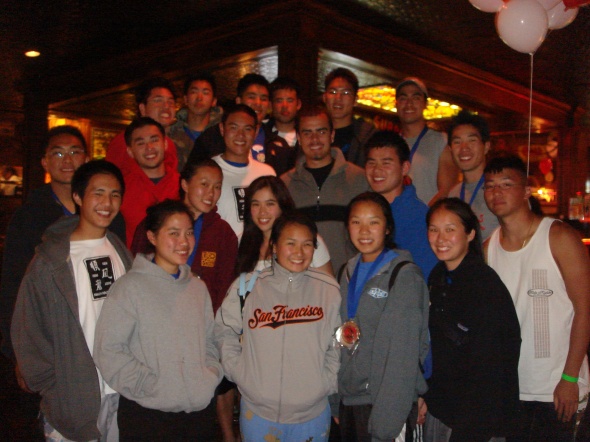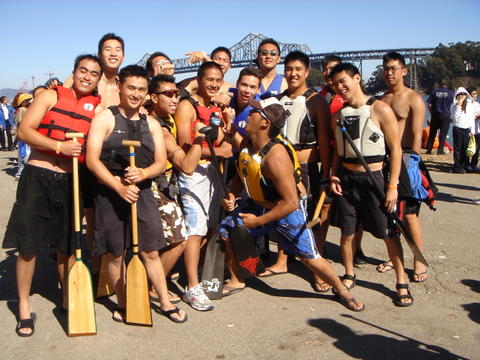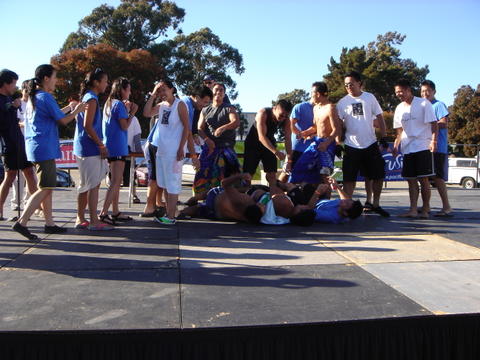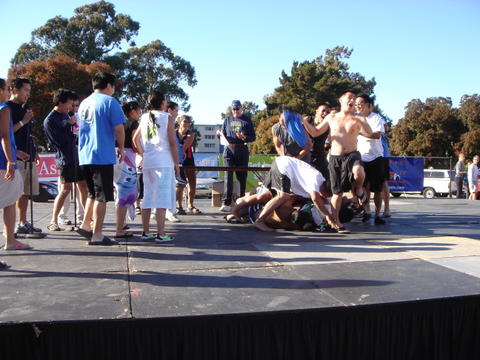Physics of Acceleration
Acceleration = (final velocity – initial velocity) / (time at finish – time at start)
Basically, the more you change your speed in a shorter amount of time, the more you have accelerated. Having a race start that features high acceleration is often a strong deciding factor in races of shorter distance and where the average speed of boats are closely matched. With the 2017 CDBA Sprint Races just having finished this past weekend, it’s time for teams to start working the long game in prep for more 500m racing fun this summer.
What I wanted to write about regarding acceleration in race starts is to address the wide variation in how teams fiddle with stroke counts and stroke technique in hopes of finding an edge over their competitors.
Many coaches I’ve spoken with over the years often have one of two philosophies about race starts: don’t fix what isn’t broken OR try something different. The leave-it-be coaches may have strong personal histories of success utilizing a certain race start count and stroke style to the point where the idea of trying something new seems like it would hurt more than help team performance. That fear is completely understandable, and in certain cases, may be quite accurate. Think of the novice team trying dragon boat for their first race. The ‘ole 5-10-10 presents both a great mental and physical challenge with plenty of clacking paddles and drenched partners. Chances are that coaching different rate ratios and stroke techniques would probably be lost upon such a crew because performance is being limited by base skill. Now, take the elite paddling crew; each paddler with multiple years of racing experience and a high level of fitness. If we’re referring to a tight-knit crew with at most 1-2 new additions vs a thrown-together “dream team,” tweaking the start might also be a waste of time because the crew has perfected their start and any change is, again, probably a waste of time.
So why chase new and different race starts at all? My answer is: because no crew is the same as the next.
Getting back to acceleration, the basic philosophy of a race start is to get from dead stop at the starting line to race pace as quickly as possible. I’ll ignore “as efficiently as possible” because when it comes to 500m or less, who cares who did it the cleanest if they lost to a team with a “messy” start? If efficiency was poor in the faster team, it just means that team could have accelerated faster next time. To me, a winning start is plenty efficient no matter how it looks. Think of how noisy, messy, and almost out of control a drag race car start is compared to driving around your Prius. The dragster was efficient at accelerating like a beast while the Prius was efficient at saving fuel and not waking the neighbors. The dragster wins. Be the dragster.
But how do you know if a start is giving efficient acceleration? Well, you could test like I used to with a GPS and stopwatch or utilize buoys of known distance. Find your team’s sustainable race pace and seek to get to that speed ASAP. There’s the chance for playing around with ratios and technique. The goal is to eliminate dead-spots in acceleration on the way to full race pace. The other goal is NOT to completely overshoot race pace and exhaust the crew before you get past the 100m mark (unless 100m is the race).
On to ratios and technique, faster acceleration demands a greater amount of power. Power is the rate at which work is done. Each paddle stroke does some work. Stroke too long and slowly and power is lost. Rate up too quickly and shorten the stroke, power is also lost. The sweet spot for every team lies in the middle somewhere. Physically stronger, more explosive teams can afford to rate up faster because they can put out more power. Weaker teams may benefit from an intentionally more gradual workup.
Once the start is over, the time to accelerate is done. Some teams opt for a high stroke rate during the race because it seems “faster.” (as in people moving their bodies/paddles quickly must be making the boat move faster, right?) Well, again it depends on how the team can physically maintain their chosen race velocity. If the team can ONLY generate adequate power to sustain that chosen speed, then sure, thrash away. Their hearts will probably be running a few extra beats/min higher than a team that is able to maintain the same boat speed but at a lower stroke rate. If you have a paddling erg, you can see how your heart rate changes if you decrease the paddle resistance and hold a higher stroke rate during a time trial vs a slightly heavier pull but lower stroke rate over the same distance.
Case in point, you can see how DW drops the stroke rate but maintains their boat speed while other adjacent teams maintain high stroke rate without gaining ground:
Compare that to our video from the 2009 Sprint Race where SFL was doing dry starts with rather meek acceleration between strokes 0-2. I definitely do not think the strongest SFL team of its day could stand up to the crews of today, mostly based on the average physical fitness of modern, A-div teams.
I’m still proud to say that I was able to coach a crew of highly dedicated and passionate paddlers of a wide variety of fitness levels and skill into becoming a consistent contender for A-div podiums over the course of several seasons. Thanks for the memories, everybody!
United We Stand
Congratulations to all paddlers for a fantastic race at Treasure Island this past weekend. Huge thanks goes to those who helped us steer our heats so smoothly and precisely.
With this race concluding the season for our mixed crew, several things come to my mind. First, we just completed what I believe to be our most challenging season ever. From the strength and commitment of just a few paddlers at every practice, we’ve managed to pull together a solid crew for every race this season. Though every team at some point faces the same challenges in keeping practices productive and seats filled, SFL has always seemingly managed to do more with less. It’s a team trait that has made us great when rosters were full and kept us in competitive lanes this season.
Second, 2013 will mark SFL’s 10th anniversary. With 2 paddlers remaining from this crew, SFL has clearly been through its fair share of member turnover through the years. Be it for 1 race or 1 year on the team, every former member of SFL who has graced our boat is sorely missed. I do find it satisfying to see that many former SFL paddlers become coaches and leaders on other Bay Area teams and valued members wherever they choose to find themselves in dragon boat. As familiar faces leave the team, new faces present themselves every year; adding to the rich tapestry that is SFL.
As volatile as the roster has been over the years, the strength of the team comes from its strong bonds among teammates. Our members don’t paddle for the flag we wave, the jersey colors we wear, or the medals to be won. I would paddle my hands raw to get the team over the finish line because I know everybody on this team works just as hard alongside me. We are eclectic in our backgrounds but united in our fighting spirit towards a common goal — doing our absolute best as SFL paddlers regardless of finishing place.
The end of this 2012 season will, undoubtedly, see some of our members to other teams or to time away from the sport in general. As 2013 draws near, I am eager to greet new faces and meet new challenges as one team: united.
Until then, team. 10 years strong. You make it happen. We make it happen together.
Sprint Race 2012
Stay strong
Stay true
Stay passionate
Stay together.
Congratulations to a race well run, paddlers of SFL. This is why I coach.
Sixth on the Fifth
May Race is over and with it, the official start of the mixed dragon boat team season in the Bay Area. In a series of heats true to form, the SFL Dragon Boat Team once again demonstrated itself to be a team not to be ignored. With a single crew comprised of 75% SFL paddlers and 25% Lightwave paddlers, the team managed some of the most competitive race starts in the field. Credit goes to the Lightwave paddlers for quickly adapting to the SFL starting count with just a single practice start prior to the Seeding heat. Our token Cardinal paddler, Brendan, also did a great job at meshing in with the crew for our later races and showed us how much more in shape we could be if we could only reverse the sands of time.
Special thanks goes out to Katherine, Jeannie, Rebecca, Ashes, and Hon for helping to carry the SFL crew into A-Division 6th place.
A big thank you also must go out to those SFL paddlers who made the commitment to keep the team racing this year at May Race: Huy, Erica, Cory, Megan, Christine, Marissa, Will Huang, Will Lam, Jerome, Henley, Jacky, Allen, Jon, Marissa, Solongo, Shelley, and Derek. Thank you to short-haired Bonita for offering to paddle when we were in need.
The team of “Smooth Wind Dragons” breathes again!
SFL Origins
The 2003 San Francisco International Dragon Boat Race marked the very first appearance of the Suen Feng Loong Dragon Boat Team. About half of the team comprised of completely new paddlers, with only two or three practices under their belt. The original founding members of SFL that are still on the team as of today: Brian, Derek, Erich, and Huy.
The two people who played a significant role in putting the team together were, as most of you know, Shelley and Lily. A few other notable figures of the dragon boat community helped create SFL, but most would later move on to paddle with BAD. At the time, Shelley and Lily were both students at UC Davis, which led to the misunderstanding that SFL was a college team from the aforementioned university (even though the team also comprised of students from UC Berkeley, CCSF, Skyline College, SF State, San Jose State, and others).
I still remember the first time Shelley and Lily explained to me what dragon boat was:
Them: “Its 20 people, trying as hard as they can, to paddle 500 meters, in a grueling match of strength, strategy, and willpower, to get to the finish line first.”
Me: “Oh hell yeeeeeeeaah, let’s do it!”
Then I went home and cleaned my pants.
My next memory is ordering our brand spankin’ new paddles, and when they finally arrived in Davis, we taped ’em up with our favorite colors. I took the blue tape and made my paddle sexy as hell, while also getting every color and making Huy’s (who was back in San Francisco) as gay as I could possibly make it. Finally race ready!!
The final results of our first festival:
Mixed Recreational A Consolation: 5th Place
The top dogs of the festival:
Check out the Mixed Competitive B Division: 2009’s champion, LARD, finished 3rd place, while 2008’s champion, Jet Start, finished 2nd place.
Sound familiar?
In the following year, SFL would become a year-round team and establish itself as a college crew. SFL’s very first college championship came at the 2004 CDBA Regional Regatta in May.
The final results of SFL’s first race as a college crew:
Go SFL!
2006 San Francisco International Dragon Boat Festival
The 2006 season was one of the most successful and eventful years SFL has ever had. A sponsorship from Under Armour provided the team with brand-spankin’ new jerseys, as the team welcomed some new faces and some long-time dragon boat vets. As for the race itself, this was the first year that the CDBA welcomed a slew of international teams, truly making the event a worldwide affair.
The lineup:
Ready to take on the world!
Quite a few of this “Dream Team” would later move on to coach other teams, assisting in the growth and development of dragon boating in the Bay Area.
Though at the young, tender age of 4, SFL had achieved quite a lot:
Four years of excellence.
2006 was the first time SFL took 1st place in the College Division at Long Beach, and we kept the momentum going into TI:
Under 2:10, as we edged out the ever-strong Cal team and take 1st place. SFL would maintain that momentum heading into the 2nd Annual College Championships a month later, with one of the team’s most impressive outings ever.
As far as the Mixed Division goes, the 2006 Treasure Island race welcomed international newcomers from Canada and Germany, bringing the competition to new levels. However, despite all odds, SFL finishes strong:
Mixed Competitive B Champions!! A step up from last year’s second place finish in the same division. It was a very remarkable achievement, considering the increased difficulty of the competition and the wide margin of victory.
Post-race celebration:
Getting out that last bit of energy before we nap at the tent.
Other ways of killing time until/during the awards ceremony:
“Whoa!!!”
My personal favorite:
“How many people does it take to measure Leslie’s height?”
And finally, after the long wait, our moment of glory finally arrives:
Yippee!!!
After receiving our awesome medals, the boys rejoice with glee. The celebration jump was fun:
… but the landing… not so much.
The celebration continues, as the team attempts to douse Jeff…
… but he darts like a true champ!
Later in the evening, we held a farewell dinner party for Jeff, who was leaving the team to study at Cal Poly:
To this day, nine of the 2006 squad still remain. Can you guess who’s missing from the picture?
And, of course, a farewell wouldn’t be complete without awkward man hugs:
And thus, the captain/coach Jeff Ma era came to an end, but Jeff would return and continue as our steersman (the best damn steersman dragon boat has ever seen, actually). When it comes to SFL, goodbye never means forever.
- Mixed Competitive B Championship: 1st Place
- College Cup: 1st Place – College Champions
2005 San Francisco International Dragon Boat Festival
The year was 2005: Huy still had hair and, yes, SFL actually had one white dude. The 2005 SF International Dragon Boat Festival marked many firsts:
- The first time the race was held at Treasure Island, where it has taken place for the past four years. Previously, the race was held at Lake Merced.
- The first (and only) time the race was held in August; we only had about 3 weeks of practice between Long Beach and TI.
- SFL’s first time racing in the competitive division at this international race. Previously, we competed in the recreational division (before we were a “year-round” team).
- Coach Geoff’s first race with SFL.
The lineup:
Courtesy of SFL’s drummer: Shelley’s older sister, Stacey.
It was also one of the first times that SFL combined forces with CCSF – the now-defunct City College of San Francisco Dragon Boat Team, led by Coach Bryan of Washington High School – to enter into the gender races.
SFL Women:
SFL Men:
Both squads would finish 5th in their respective heats, but it would be the beginning of an alliance with CCSF that culminated in the domination of the 2006 College Cup gender races.
Despite being SFL’s first year in the competitive division for the race, we finished with a strong second in the B Division Championships:
 Top 3 with Killer Guppies and DW? That’s good company.
Top 3 with Killer Guppies and DW? That’s good company.
And, of course, we saw continued success in the college division, as we edged out a powerful Cal team to claim our fourth 1st place college championship:
And so, on to the ridiculous on-stage celebration:
I don’t remember why there was a dogpile. Also, some nut thought it would be cool to throw his shirt into the audience:
Let’s just say that SFL wasn’t known for being classy, but there ain’t nothin’ wrong with that.
And finally, any flashback wouldn’t be complete without the team photo:
- Mixed Competitive B: 2nd Place
- College Cup: 1st Place – College Champions






